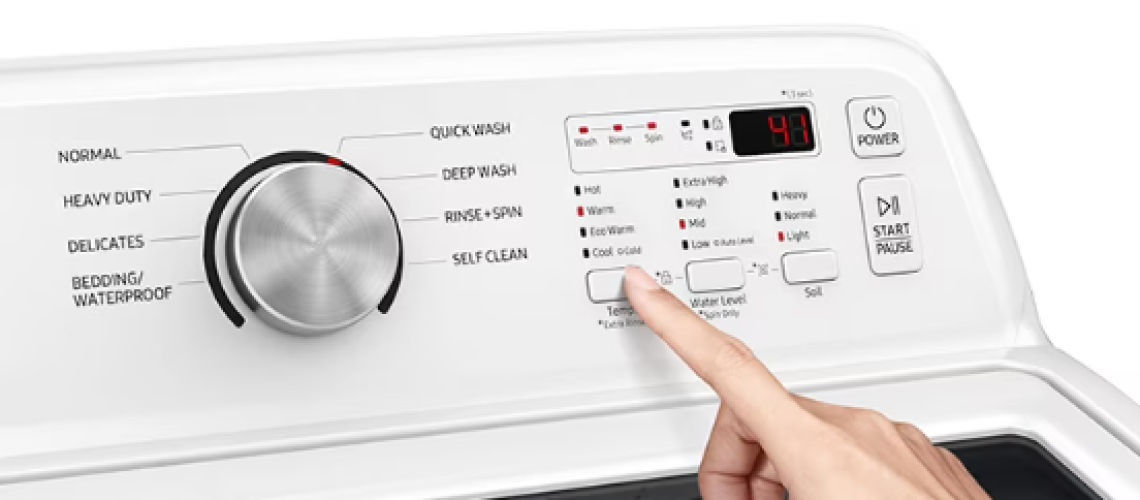Keeping your laundry clean starts with maintaining the appliance at the heart of it all – your washing machine.
Among household appliances, the humble washing machine performs an unenviable task, consistently tackling dirt, grime, and an array of stains. As such, it deserves our utmost attention when it comes to maintenance and care.
If you’re a proud owner of a Samsung washer, you’re in possession of a top-of-the-line appliance designed with innovative features to ensure optimal performance. One such feature is the self-clean function, a convenience that makes maintenance a breeze.
But how do you utilize this feature effectively, and what other cleaning methods should you consider for a washer without this function?
This comprehensive guide will walk you through the nuances of keeping your Samsung washer in the best possible condition, highlighting how to exploit the self-clean function and alternative cleaning strategies.
Read on to uncover the secrets to a cleaner, more efficient Samsung washing machine and, by extension, fresher, brighter laundry.
Understanding the Self-Clean Function
Samsung has developed an in-built self-clean function in their washers specifically designed to maintain the cleanliness of the machine. This unique feature provides an efficient, easy-to-use option for regular cleaning maintenance, a significant leap from the traditional methods of scrubbing and cleaning a washer’s interior.
Initiating the Self-Clean Process
To start the self-clean process, make sure the washer is entirely devoid of any clothing or laundry items. You will then need to locate and press the Self Clean button on the control panel, then press the Start button. This initiates the cleaning process which can take several hours, depending on your washer’s model.
Cleaning Agents During Self-Clean
During the self-clean cycle, Samsung advises that there is no need to add any cleaner, a clear difference from many manual washing machine cleaning routines. The machine is designed to efficiently clean itself without the aid of any cleaning agents. However, for those battling an existing mold smell, Samsung’s guidelines allow the usage of bleach.
The Importance of Regular Cleaning
Regular cleaning of your Samsung washer is imperative to prevent any odor build-up and mold, ensuring your washer continues to function at its optimal capacity. The company recommends cleaning the machine once every month, but the frequency can change depending on the usage.
Smart Cleaning with Self Clean+
Samsung’s advanced models come with a Self Clean+ feature. This is an intelligent functionality that notifies the user after every forty wash cycles, indicating that it’s time for a cleaning. If your household has a large family or if your washer usage is frequent, this feature comes in handy to maintain the cleanliness of your appliance.
Preparing for the Self-Clean Cycle
Before you run the self-clean function, certain steps need to be taken to ensure the process is effective. These include making sure the washer is empty, the machine is plugged in and turned on. For any unpleasant smells, add bleach into the detergent drawer.
Dealing with Soap Suds
If you notice an accumulation of soap suds in your Samsung washer, running a second self-clean cycle is highly recommended. The additional cycle will effectively remove the soap suds and prevent them from causing any issues during your laundry sessions.
Using the Self-Clean Function
The self-clean function works to meticulously clean the washer’s drum. This process is automated and does not require the use of chemicals or intervention from a technician. Known as Pure Cycle or Self Clean+, this feature specifically targets mold and areas of the tub that are prone to accumulating moisture and detergent residue.
Time Required for Self-Clean
Depending on your machine model, the self-clean function takes varying durations to complete. For top-loader washers, the self-clean process takes around one hour. On the other hand, front-loader washers require approximately four hours to fully clean themselves.
Water Conservation with Self-Clean
Samsung’s self-clean function is designed with environmental consciousness in mind. The process uses the minimal amount of water necessary, which contributes to significant water conservation. This is an essential aspect in today’s world, where resources are becoming increasingly scarce.
Limitations of the Self-Clean Function
Despite its effectiveness, the self-clean function has certain limitations. For instance, it’s not designed to remove stains from your clothes. To deal with stains, you need to use the appropriate wash cycle and detergent recommended by Samsung.
Cleaning vs. Stain Removal
While the self-clean function focuses on cleaning the washer’s interior, specifically targeting mold and areas with moisture and detergent residue, it’s important to understand that it won’t help with stain removal on your clothes. Stains require specific cleaning cycles and appropriate detergents to get rid of.
Benefits of the Self-Clean Function
Using the self-clean function on a Samsung washer comes with numerous benefits. It eliminates dirt, grime, and bacteria, and prevents mold and mildew buildup. The function also promotes water conservation, maintains your washer’s efficiency, and saves you from having to use chemicals or call in a technician.
How the Self-Clean Function Works
The self-clean function works by immersing the tub in water, which loosens any accumulated dirt. The tub then spins at high speeds to detach the dirt and mold and rinse it away. By specifically targeting areas that accumulate mold, moisture, and detergent residue, the self-clean function ensures the elimination of dirt, grime, and bacteria over time.
Alternatives to Self-Clean Function
In some cases, your Samsung washer might not come with a self-clean function. In this instance, Samsung recommends using either bleach or a washing machine cleaning product to clean your appliance. However, it’s important to carefully follow the instructions associated with the chosen cleaner, as these can vary from product to product.
Bleach vs. Washing Machine Cleaning Products
When considering bleach or a washing machine cleaning product as your chosen cleaning method, note that they serve different purposes. While bleach can be used to clean the washer’s drum and eliminate odors and mold, washing machine cleaning products offer specific solutions depending on their formulation. Ensure you follow the instructions for the product you choose to achieve the best results.
Concluding Thoughts
Ultimately, the self-clean function is an effective and convenient method to clean your Samsung washer.
It requires less effort, saves water, and eliminates the need for potentially harmful chemicals. Nonetheless, if your washer lacks this feature, bleach or washing machine cleaning products still provide a robust cleaning solution.
Regular cleaning ensures your washer continues to function at its optimal capacity, increasing its longevity and ensuring fresh, clean laundry every time.
Fun Facts About Samsung
| Did You Know These Things About Your Samsung Washer? |
|---|
| Innovative Design: Samsung washing machines are renowned for their innovative and modern design. Some models feature a small door in the main door, called an “AddWash” door, allowing you to add forgotten items even after the wash cycle has started. |
| Smart Capabilities: Many Samsung washers come with smart capabilities. You can connect them to your Wi-Fi network and control them remotely through an app on your smartphone. This includes starting a wash cycle, receiving alerts when a cycle is finished, and even diagnosing problems. |
| Eco Bubble Technology: Some Samsung washing machines utilize Eco Bubble technology, which transforms your detergent into bubbles to penetrate fabrics faster. This means you can wash at cooler temperatures without compromising on cleaning performance. |
FAQs About Cleaning Your Samsung Washer
Q: Can I use vinegar instead of bleach to clean my Samsung washer?
A: While vinegar is often used in DIY cleaning solutions, Samsung does not recommend using it to clean their washers as it may damage the internal parts. It’s best to stick with their recommended method of using the self-clean function or bleach.
Q: How do I know if my Samsung washer has a self-clean function?
A: You can check your washer’s control panel for a button labeled ‘Self Clean’, ‘Pure Cycle’, or ‘Self Clean+’. If you can’t find one, check your user manual or contact Samsung customer service.
Q: What should I do if my washer still smells after running the self-clean cycle?
A: If your washer continues to smell after running the self-clean cycle, you may need to run the cycle again with bleach. If this doesn’t help, it might be time to contact a professional to inspect your washer.
Q: Can I add clothes to the washer during the self-clean cycle?
A: No, you should not add clothes to the washer during the self-clean cycle. The washer should be completely empty during this process to ensure it’s properly cleaned.
Q: How can I prevent mold and mildew in my Samsung washer?
A: Regularly running the self-clean cycle is one way to prevent mold and mildew. In addition, leaving the washer door open after each cycle allows the inside to dry out and prevents the buildup of moisture that can lead to mold and mildew.


